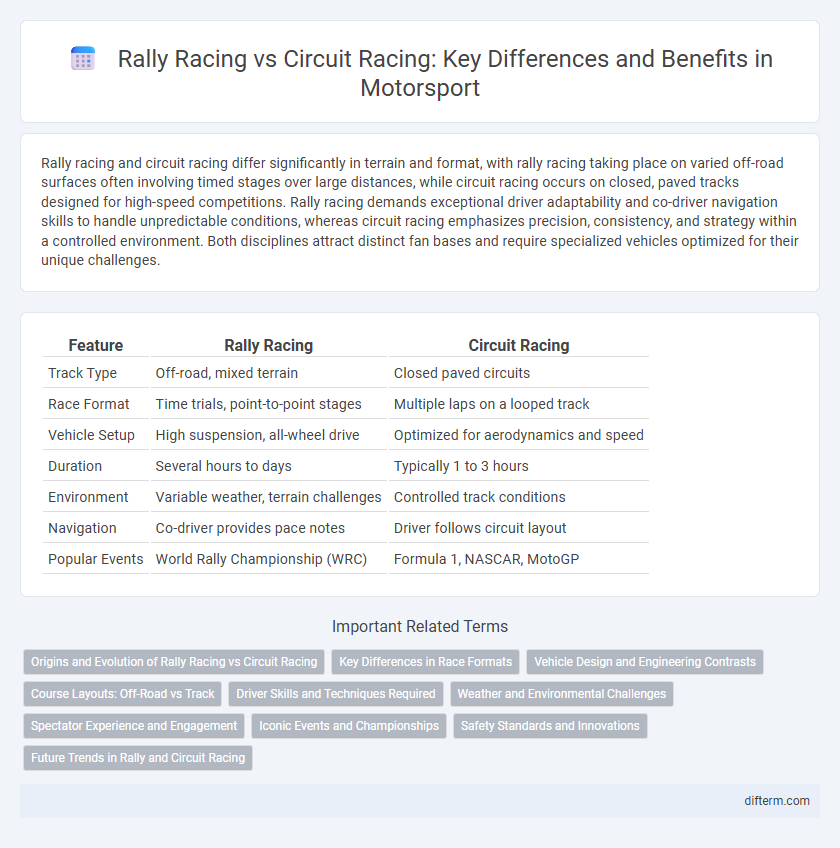Rally racing and circuit racing differ significantly in terrain and format, with rally racing taking place on varied off-road surfaces often involving timed stages over large distances, while circuit racing occurs on closed, paved tracks designed for high-speed competitions. Rally racing demands exceptional driver adaptability and co-driver navigation skills to handle unpredictable conditions, whereas circuit racing emphasizes precision, consistency, and strategy within a controlled environment. Both disciplines attract distinct fan bases and require specialized vehicles optimized for their unique challenges.
Table of Comparison
| Feature | Rally Racing | Circuit Racing |
|---|---|---|
| Track Type | Off-road, mixed terrain | Closed paved circuits |
| Race Format | Time trials, point-to-point stages | Multiple laps on a looped track |
| Vehicle Setup | High suspension, all-wheel drive | Optimized for aerodynamics and speed |
| Duration | Several hours to days | Typically 1 to 3 hours |
| Environment | Variable weather, terrain challenges | Controlled track conditions |
| Navigation | Co-driver provides pace notes | Driver follows circuit layout |
| Popular Events | World Rally Championship (WRC) | Formula 1, NASCAR, MotoGP |
Origins and Evolution of Rally Racing vs Circuit Racing
Rally racing originated in the early 20th century, evolving from endurance tests on public roads, emphasizing navigation and varying terrains, while circuit racing began with organized closed-track competitions designed for speed and precision. Rally racing's evolution highlights adaptations to rugged landscapes and time trials, contrasting with circuit racing's advancements in lap timing and vehicle aerodynamics on controlled circuits. Both disciplines have deeply influenced motorsport technology and culture but maintain distinct challenges rooted in their origin stories.
Key Differences in Race Formats
Rally racing features point-to-point stages on varied terrain such as gravel, dirt, and snow, testing driver adaptability and co-driver navigation skills against the clock. Circuit racing occurs on closed, paved tracks where multiple cars compete simultaneously in a looped format emphasizing consistent lap times, overtaking tactics, and vehicle setup precision. The fundamental distinction lies in rally's focus on individual timed intervals across diverse environments versus circuit racing's direct, head-to-head competition on standardized tracks.
Vehicle Design and Engineering Contrasts
Rally racing vehicles feature reinforced chassis, high ground clearance, and specialized suspension systems to endure diverse, rough terrains, contrasting with circuit racing cars designed for maximum aerodynamic efficiency, low ground clearance, and optimized handling on smooth, paved tracks. Rally cars often include all-wheel drive systems to enhance traction in variable conditions, while circuit racers prioritize lightweight construction and advanced downforce technologies to achieve superior speed and cornering stability. Engineering in rally racing focuses on durability and adaptability, whereas circuit racing emphasizes precision, speed, and aerodynamic performance.
Course Layouts: Off-Road vs Track
Rally racing features off-road course layouts with diverse terrains such as dirt, gravel, snow, and mud, demanding adaptive driving skills and vehicle durability. Circuit racing occurs on paved tracks with consistent surfaces designed for high-speed handling, precise cornering, and strategic overtaking. These distinct course layouts influence vehicle setup, driver techniques, and race strategies uniquely in each motorsport discipline.
Driver Skills and Techniques Required
Rally racing demands exceptional adaptability and precise car control on diverse terrains, requiring drivers to master techniques like left-foot braking, rapid pace note interpretation, and terrain reading. Circuit racing prioritizes high-speed consistency, optimal racing line execution, and precision in braking and cornering under intense competition conditions. Both disciplines necessitate advanced spatial awareness and split-second decision-making, but rally drivers excel in unpredictable environments while circuit racers specialize in strategic track management.
Weather and Environmental Challenges
Rally racing faces intense weather and environmental challenges, with drivers adapting to unpredictable terrains such as mud, snow, and gravel on natural, off-road courses. Circuit racing occurs in controlled environments with paved tracks, minimizing weather impacts but still requiring strategies for rain or extreme heat. The dynamic weather conditions in rally racing demand versatile vehicle setups and heightened driver skill to maintain performance and safety.
Spectator Experience and Engagement
Rally racing offers spectators a dynamic and immersive experience with unpredictable terrain, close encounters, and multiple viewing points along extensive routes. Circuit racing provides concentrated action in a single location, allowing fans to follow the race closely with grandstands, big screens, and interactive fan zones. Both formats engage audiences differently, with rally racing emphasizing adventure and exploration, while circuit racing delivers continuous, high-speed excitement.
Iconic Events and Championships
Rally racing is highlighted by iconic events such as the World Rally Championship (WRC), featuring diverse terrains and time trial stages that test driver skill and vehicle endurance. Circuit racing centers on prestigious championships like Formula 1 and the 24 Hours of Le Mans, emphasizing speed, strategy, and precision on closed-loop race tracks. Both disciplines boast legendary competitions that attract global audiences and showcase cutting-edge automotive technology.
Safety Standards and Innovations
Rally racing prioritizes advanced safety standards such as reinforced roll cages, fire suppression systems, and specialized helmets to protect drivers in unpredictable off-road conditions. Circuit racing innovations focus on aerodynamic crash structures, high-tech impact-absorbing barriers, and real-time telemetry for immediate accident response. Both disciplines continuously evolve safety protocols to reduce risks, leveraging cutting-edge materials and technology to enhance driver protection.
Future Trends in Rally and Circuit Racing
Electric vehicle technology is rapidly advancing in both rally and circuit racing, with championships increasingly integrating electric and hybrid cars to reduce environmental impact and enhance performance. Autonomous systems and AI-driven data analytics are shaping race strategy optimization, driver safety, and vehicle diagnostics, offering real-time decision-making advantages. The growing use of sustainable fuels and digital fan engagement platforms also highlight the shift toward eco-friendly practices and immersive spectator experiences in motorsports.
rally racing vs circuit racing Infographic

 difterm.com
difterm.com